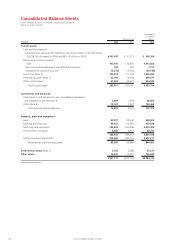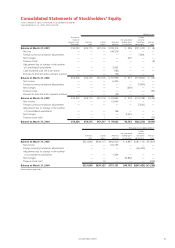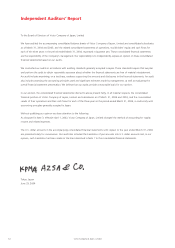JVC 2004 Annual Report Download - page 46
Download and view the complete annual report
Please find page 46 of the 2004 JVC annual report below. You can navigate through the pages in the report by either clicking on the pages listed below, or by using the keyword search tool below to find specific information within the annual report.
Victor Company of Japan, Limited44.
The ranges of useful lives for computing depreciation are
generally as follows:
Buildings 20 to 50 years
Machinery and equipment 3 to 7 years
Accounting standard for impairment of fixed assets
In the year ended March 31, 2004, the Company did not adopt
early the new accounting standard for impairment of fixed Assets
(“Opinion Concerning Establishment of Accounting Standard for
Impairment of Fixed Assets” issued by the Business Accounting
Deliberation Council on August 9, 2002) and the implementation
guidance for accounting standard for impairment of fixed assets
(the Financial Accounting Standard Implementation Guidance No.
6 issued by the Accounting Standards Board of Japan on October
31, 2003). These standards are required to be adopted in periods
beginning no later than on April 1, 2005.
Finance leases
Finance leases, except those leases for which the ownership of the
leased assets is considered to be transferred to the lessee, are
accounted for in the same manner as operating leases.
Research and development
Research and development expenditures for new products or
significant improvement of existing products are charged to income
as incurred.
Income taxes
Income taxes are accounted for under the asset and liability
method. Deferred tax assets and liabilities are recognized for the
estimated future tax consequences attributable to differences
between the financial statement carrying amounts of existing
assets and liabilities and their respective tax bases and net operat-
ing loss carried forward and foreign tax credit carry forwards.
Deferred tax assets and liabilities are measured using enacted tax
rates expected to apply to taxable income in the years in which
those temporary differences are expected to be recovered or
settled. The effect on deferred tax assets and liabilities of a change
in tax rates is recognized in income in the period that includes the
enactment date.
Employees’ severance and retirement benefits
The Company has funded pension plans and unfunded benefit
plans to provide retirement benefits for substantially all employees.
Upon retirement or termination of employment for reasons other
than dismissal for cause, eligible employees are entitled to lump-sum
and/or annuity payments based on the current rates of their salary
and length of service.
The liabilities and expenses for severance and retirement benefits
are determined based on the amounts actuarially calculated using
certain assumptions.
The Company provided allowance for employees’ severance and
retirement benefits as of the balance sheet dates based on the
estimated amounts of projected benefit obligation and the fair
value of plan assets at those dates.
The excess of the projected benefit obligation over the total of
the fair value of plan assets as of April 1, 2000 and the liabilities
for severance and retirement benefits recorded as of April 1, 2000
(the ”net transition obligation”) is recognized in expenses in equal
amounts primarily over 15 years commencing with the year ended
March 31, 2001.
Prior service costs are recognized in income or expenses using
the straight-line method over 10 years, and actuarial gains and
losses are recognized in expenses using the straight-line method
over 10 years commencing with the succeeding period.
Amounts per share of common stock
The computation of net income per share is based on the weighted
average number of shares of common stock outstanding during
each year.
Diluted net income per share assumes dilution that could occur
if convertible bonds or similar securities were converted into
common stock resulting in the issuance of common stock. As the
Companies reported net losses for the year ended March 31,
2002, inclusion of potential common shares would have an
antidilutive effect on per share amounts.
Effective April 1, 2002, the Companies adopted the new
accounting standard for earnings per share and related guidance
(Accounting Standards Board Statement No. 2, “Accounting
Standard for Earnings Per Share” and Financial Standards
Implementation Guidance No. 4, “Implementation Guidance for
Accounting Standard for Earnings Per Share”, issued by the
Accounting Standards Board of Japan on September 25, 2002).
The effect on earnings per share of the adoption of the new
accounting standard was not material. Such amounts for the year
ended March 31, 2002 have not been recalculated using the new
accounting standard.
Cash dividends per share represent the actual amount declared
as applicable to the respective years.
Accounting standard for treasury stock and reversal of
statutory reserves
Effective April 1, 2002, the Companies adopted the new account-
ing standard for treasury stock and reversal of statutory reserves
(Accounting Standards Board Statement No. 1, “Accounting
Standard for Treasury Stock and Reduction of Statutory Reserves”,
issued by the Accounting Standards Board of Japan on February
21, 2002).
The adoption of the new accounting standard had no impact
on net income. However, as a result of adopting this new
accounting standard and application of the related revised disclosure
requirements, stockholders’ equity accounts in the accompanying
balance sheet as of March 31, 2003 are presented differently from
prior years.
Reclassifications
Certain prior year amounts have been reclassified to conform to
the 2004 presentation. These changes had no impact on previ-
ously reported results of operations or stockholders’ equity.
3. CHANGE IN ACCOUNTING METHOD
The Company changed the method of accounting for royalty
income and related expenses. Under the former method, the net
amount of the two items was included in the statements of opera-
tions as royalty income—net, under other income (expenses).
Effective April 1, 2002, royalty income is included in net sales,
and the related expenses are included in selling, general and
administrative expenses.
This change reflects the recognition that royalty income is
directly attributable to the Company’s principal operating activities,
in light of the increasing number of technological alliances with
partners both in Japan and overseas, and their growing strategic
significance. Therefore, royalty income and the related expenses
























